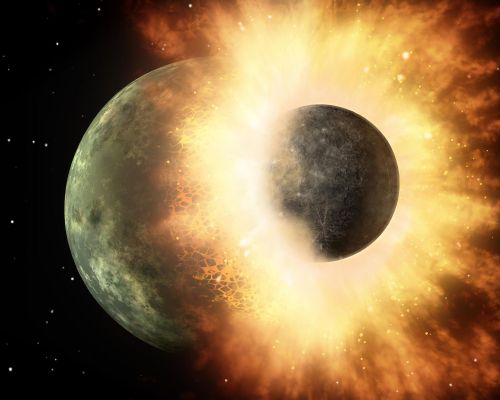
“Obviously, we have no idea what really happens when planets collide, because we can’t build planets in the lab and smash them together,” said Jacob Kegerreis, a postdoctoral researcher in a specialist lab at the U.K.’s Durham University called the Institute for Computational Cosmology.
So Kegerreis and his colleagues did the next best thing: They booked time on a supercomputer and used it to run hundreds of simulations of planets crashing into one another — a demolition derby for astrophysics geniuses.
“It’s all about doing calculations,” he told Digital Trends. “There’s no reason you couldn’t do it by hand, it would just take forever. It’s really exactly how video games work. If you’ve got a character — even a 2D one like Mario — and you need them to jump and fall back down under gravity, that means the program has an equation for gravity, and it basically does a very, very simple simulation to work out how quickly that character falls. It’s really the same principle. We just try and use slightly more careful equations to do these more physics-based things.”
Solving galactic mysteries
Of course, what are to Kegerreis “slightly more” involved equations are, to the rest of us, mind-boggling magnitudes of complexity. When the researchers working on the project created their model planets, they represented them as millions of particles, each pulling one another under gravity and pushing with material pressure. The model takes into account painstakingly accurate real-life details such as how planetary materials like rock and iron actually behave at different temperatures and densities, how gravity and pressure impacts the particles, and how these particles interact according to the equations of hydrodynamics.
“We need a supercomputer because we require many millions of particles to resolve the details of what happens in these messy collisions, especially with low-density atmospheres,” he said. “This means a daunting number of calculations to do very many times in order to see how the system evolves throughout the impact.”
The simulation in the team’s most recent study potentially sheds some light on the creation of the moon. Today’s most widely accepted theory is that the moon was formed as the result of a collision between Earth and another planet about the size of Mars. It is hypothesized that the debris from this impact became trapped in Earth orbit and eventually coagulated into the moon.
But although this much is broadly agreed upon, Kegerreis said that there are “maybe five or six plausible ideas” for the specific type of impact scenario. By modeling these, the teams was able to simulate details about how much of Earth’s atmosphere would have been lost in the most popular moon-forming scenarios. Numbers, he said, range from 10 to 60 percent of the atmosphere, depending on the precise angle, speed, and planet sizes.
“These same kinds of simulation, in terms of the physics that’s going on underneath, can be used for loads of different things.”
“If we can understand the history of Earth’s atmosphere well enough, then it might help us narrow down how erosive an impact the moon-forming collision should have been,” he said. “Or at least to perhaps rule out scenarios that remove far too much or far too little atmosphere to fit the observations.”
Research such as this could therefore help answer some fundamental questions about the reason the observable universe is the way it is. “[In this case,] we weren’t sure whether it was really easy or really hard for a giant impact to remove all of an atmosphere, or whether it was possible to get middling erosion as opposed to all or nothing,” Kegerreis said. “We also looked at the possibility of the impactor delivering atmosphere if it had some of its own to begin with.”
A simulator for the entire universe
While this project may be concluded, Kegerreis is excited about the future possibilities. He’s also enthused at the development of the simulation code the team wrote to carry out their work, in association with a group of astronomers and computer scientists. Called SWIFT, it’s an open-source hydrodynamics and gravity computer program that could be used by researchers anywhere in the world (so long as they have remote access to a supercomputer) to run simulations of astrophysical objects, including planets, galaxies, or even, conceivably, the whole universe.
“These same kinds of simulation, in terms of the physics that’s going on underneath, can be used for loads of different things,” Kegerreis said. “Here in Durham, the main thing that people actually use similar simulations to do is galaxy formation and much wider cosmology things where you’re evolving dark matter, stars, and galaxies, rather than smaller things like planets. We can use the same simulation code to do those different things just by putting in different variations of the specific equations that we’re solving. But it’s the same basic structure.”
The lack of real-time graphics (think endless code running on a screen, rather than than Civilization on a galactic scale) means this won’t have the makings of a hit video game any time soon. However, it might just wind up helping reveal some of the secrets of the universe, from the Big Bang to the present day. As trade-offs go, that’s not a bad one.
A paper describing the latest project, titled “Atmospheric Erosion by Giant Impacts onto Terrestrial Planets: A Scaling Law for any Speed, Angle, Mass, and Density,” was recently published in the journal Astrophysical Journal Letters.